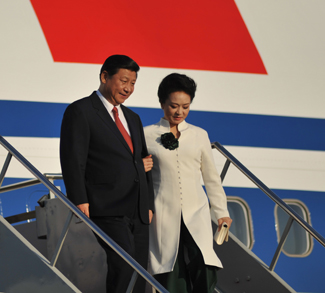The Astana International Financial Centre (AIFC) has taken the next step in its quest to become a Central Asian investment hub by opening the first session of the Astana International Exchange (AIX) in mid-November. Considering that the AIFC only officially commenced its operations in July, it is too early to predict whether it will be successful or not, but, for the time being, Astana can be pleased with the AIFC’s promising first steps.
The author of this report has previously discussed the AIFC for Geopolitical Monitor (“The Astana International Financial Centre: Kazakhstan’s Ambitious Step Forward”), hence we will solely focus on recent developments.
The first session of the AIX included the trading of shares for Kazatomprom, the world’s largest producer of uranium. “We have executed a successful IPO [initial public offering], proving the status of the world uranium industry leader, and have become the first company listed on the Astana International Exchange,” said Galymzhan Pirmatov, CEO of Kazatomprom National Company. Unconditional trading in Kazatomprom’s global depositary receipts began on November 19, KazInform reported. Additionally, some 49 foreign and 16 Kazakh companies, as well as some 2,700 Kazakh citizens presented their shares on the stock exchange on opening day, according to other reports.
Another important development is that Goldman Sachs has acquired 108,480 ordinary shares. These represent a “4.1 per cent of the total issued share capital (post-money) of AIX while simultaneously entering into a 5 year put option with AIFC to protect Goldman Sachs against a decline in the value of the shares below the purchase price,” the AIFC explained.
In the near future, there are plans for the the AIX to trade shares of other state-run companies such as Kazakhtelecom, Air Astana, KazMunaiGas, among others. The obvious objective, other than to cement AIX as the country’s premier stock exchange, is to convince foreign investors that they too should utilize this new agency. Adding to the enticement is the fact that the AIFC’s International Arbitration Centre is based on English Common law. Moreover, if the AIFC is trying to attract Western investment it helps to have a brand name like Goldman Sachs attached – not to mention NASDAQ and the Shanghai Stock Exchange. Curiously, coinciding with the AIX’s first trading session, a delegation from Slovakia, headed by Prime Minister Peter Pellegrini, visited the AIFC’s facilities, hinting that the Central European government may be interested in the new initiative.
Dr. Ariel Cohen, a non-resident Senior Fellow at the Atlantic Council’s Eurasia Center, praised the AIFC at a 4 December conference in Washington DC titled “Future Calling: Infrastructure Development in Central Asia” for what it could mean for Kazakhstan. He explained that the AIFC “is a transition from a 20th century natural resources-based proposition to a 21st century investment and financial services added value proposition.” Meanwhile, another panelist, Catullus Helmer, Co-Founder and Partner at Enovid LLP, argued that “the AIFC and the AIX have already been a success” if we regard these newborn initiatives not as the next London Stock Exchange, but rather as “a haven, bellwether, and a benchmark for the rule of law, institutions, and the business environment.”
Kazatomprom: Up for (Partial) Auction
As previously mentioned, Kazakh heavyweight Kazatomprom which, by the company’s own estimates is valued at between USD$3-4 billion, was the first company to be traded at AIX. Apart from producing uranium, the company also “manufactures and sells beryllium and tantalum products; produces, transfers, and sells electric and heat energy; produces and sells potable, technical, and distilled water; among other services, according to Bloomberg. “Kazatomprom also traded at the London Stock Exchange, raising $451 million. 5.5 million shares were sold in Astana, including 3.93 million actual shares and 1.6 million of Global Depositary Receipts,” reported Forbes.
The selling of Kazatomprom shares is important, but should not be overestimated. As the Jamestown Foundation explains, Kazakhstan’s sovereign wealth fund Samruk Kazyna “will remain the majority shareholder and will continue to exert effective control over company operations;” hence it comes as no surprise that the plan is to sell no more than 15 percent of shares to outside investors. Then again, as the article also notes, “if Kazatomprom becomes a public company, it will be only the second major uranium miner in the world, after Canada’s Cameco, to obtain such a status.” The partial privatization of this company is a good example of Astana giving up (partial) control of its profitable state-run enterprises, beginning with the crown jewel, Kazatomprom, in order to attrack a more global clientele.
Ambitious Goals
The AIFC’s raison d’être is ambitious: to become the country’s main financial hub and one of the leading financial centers of Asia in the shortest possible time, which will help the Central Asian state become one of the top 30 most developed nations by 2050. The Centre was launched this past January, though it only started operating in July; and in November the AIX opened.
The role of Goldman Sachs and the partial privatization of an important company like Kazatomprom are attractive first steps. Another factor that could also attract investors is the Central Asian state’s ranking in the “Doing Business 2018: Reforming to Create Jobs” report by the World Bank. In the latest report, Kazakhstan ranks number 36 in the “Ease of Doing Business Ranking” section, with Switzerland at 33, Japan at 34, Russia at 35 and Slovenia at 37, out of 190 states that were analyzed. The next Central Asian state is Uzbekistan at number 74. Even more, the report notes that “thirteen economies [including Kazakhstan] passed legislation in 2016/17 that increased corporate transparency requirements,” in addition to strengthening minority investor protections by increasing shareholder rights and their role in major corporate decisions. Thus, Kazakhstan is in an expectant place and we will have to see if the AIFC manages to increase the country’s position further in the coming years.
Of course, the future of the AIFC is not free of challenges. One obvious issue is that the Kazakh market and capital alone are not big enough to remain constantly active, and attractive. At the Atlantic Council event, Dr. Cohen explained that the AIFC can succeed “provided it is not limited just to Kazakhstan.” Hence, AIFC’s priority is to present itself as the natural conduit though which investors can make business with other Central Asian nations.
This will be achieved if the AIFC’s agencies are successful. For example, if the International Arbitration Centre successfully manages a dispute between Western company “X” and Central Asian country “Y” in a manner which both sides regard as professional and whose outcome is regarded as acceptable, this will increase the AIFC’s international pedigree. We will have to wait and see how the Arbitration Centre deals with cases once they start coming in, but at least the IAC seems to be well staffed, as it is chaired by Barbara Dohmann QC, a well-known UK commercial barrister. The Kazakhs have imported “high quality expertise” to the IAC, remarked Dr. Cohen at the Atlantic Council event.
There is also a foreign policy aspect to the AIFC’s success, as the Kazakh government will have to maintain cordial and friendly relations with the other Central Asian states (relations with Uzbekistan have steadily improved since the new president came to power) in order to maintain borders open in order to promote freedom of movement and trade.
The AIFC and Kazakhstan
If the AIFC works as expected, and greater investment and industries come from Europe, Japan, South Korea and the United States, this will also help diversify Kazakhstan’s economy. An October 2018 report by the Project on Prosperity and Development, part of the Center for Strategic and International Studies, entitled “The Future of Global Stability The World of Work in Developing Countries Kazakhstan Case Study,” explains this situation well. “Kazakhstan was one of the fastest-growing economies in the world during the natural resources boom of the 1990s,” the report explains, adding that it “has shown great progress in formal job creation. Between 2003 and 2013, annual employment growth was 2.1 percent, compared to the total labor force growth of 1.7 percent. During this period, a total 1.5 million jobs were created.”
However, there is government-acknowledged over-reliance on natural resource extraction, namely oil and gas. The CSIS report argues that, “construction, mining, and agribusiness are among the sectors projected to be the most promising for economic growth in the next 10 to 15 years, but challenges to the labor market remain,” including a large informal job sector. If oriented correctly, the AIFC could bring companies and externally-backed projects that would help diversify the Kazakh economy: e.g. constructing roads to help the agricultural sector.
Conclusion
There is an understandable degree of international skepticism about the AIFC’s ambitious objectives. Plenty of projects around the world begin with great fanfare only to collapse. However, what the AIFC has achieved in its firsts months of operations is commendable, which should help convince the international financial community to look at the AIFC as viable conduit for investment in Kazakhstan, and potentially the rest of Central Asia.
Wilder Alejandro Sanchez is an analyst who focuses on geopolitical, military, and cybersecurity issues. The views expressed in this article are those of the author alone and do not necessarily reflect those of Geopoliticalmonitor.com or any institutions with which the author is associated.




